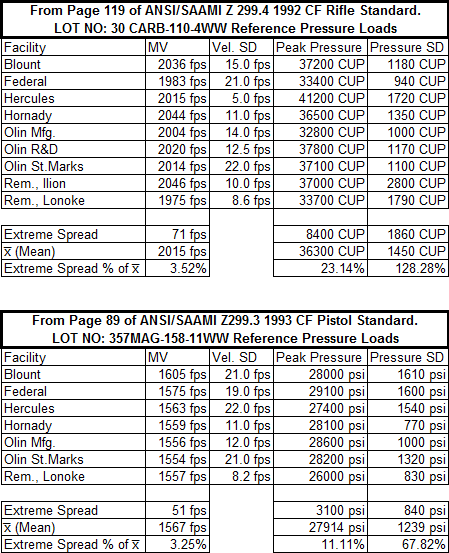ShootistPRS said:
The current SAAMI maximum average pressures for the 357 magnum are only 33000 psi they may be slightly over pressure but if you consider that the SAAMI pressures have been dropped first 5000 psi and then another 2000 psi, after S&W petitioned SAAMI because the loads were shaking the side covers off their smaller revolvers, you know that in a gun that can take the pressures (look at the Ruger and Contender loads) you have a considerable margin for higher loads.
Are you telling me the .357 Magnum used to be rated at 52,000 CUP, same as the .308 Winchester and .223 Remington, and a bunch of other cartridges? I don't think so. Not for the skinny edge of a revolver cylinder.
Nick_C_S said:
Yep. True. IMO, it's just as well. These days, I'm just fine keeping my loads to current published data; and thus presumably, 33K max. That's plenty of juice for me.
This is just persistent rumor, AFAIK. The 45,000 CUP MAP is still in the SAAMI standard, unchanged from after Elmer Keith loaded to sticky extraction, reduced 5%, and the resulting loads were put through copper crusher testing.
When I noticed this claimed drop in pressures was being repeated with authority in forum posts a decade ago, I decided to go to an actual authority to inquire. I called then SAAMI technical director, Ken Greene, and asked about it. He said the illusion is created by the fact the copper crusher rating is 45,000 CUP, while the newer conformal transducer standard is 35,000 psi. The smaller magnitude of the second number makes it appear there's been a change. But he said that is a measurement artifact. That the same reference load that produces a MAP of 45,000 CUP produces a MAP of 35,000 psi in a conformal transducer barrel. We are used to the conformal transducer giving the higher reading at rifle cartridge pressures, further convincing us the pressure was changed, but that in fact the differences are inconsistent, changing both with cartridge diameter and absolute pressure. You just cannot reliably compare the two.
For example, the .223 Rem and .308 Win are both rated at 52,000 CUP. Yet when the conformal pressure transducer is used with reference loads producing a MAP of 52,000 CUP, the .223 reads just 55,000 psi, while the .308 reads 62,000 psi. The CIP channel style transducer reads a max pressure reference load as 62,366 psi for the .223, and reads the .308 as 60,191 psi. Just the opposite of the conformal transducer, the channel transducer puts the smaller cartridge pressure higher. But it's all the same pressure based on the same reference loads shared across borders. The differences are all due to limitations of the measuring systems used and, to a lesser extent, rounding error.
This is why SAAMI has a reference load system. They know that no two copper crushers or transducers will read exactly alike, even within a type. The reference load provides a calibration factor, allowing the operator to adjust for the differences on his system and wind up making cartridges to the same pressure standard anyway, even if the absolute reading on his gear doesn't match.

